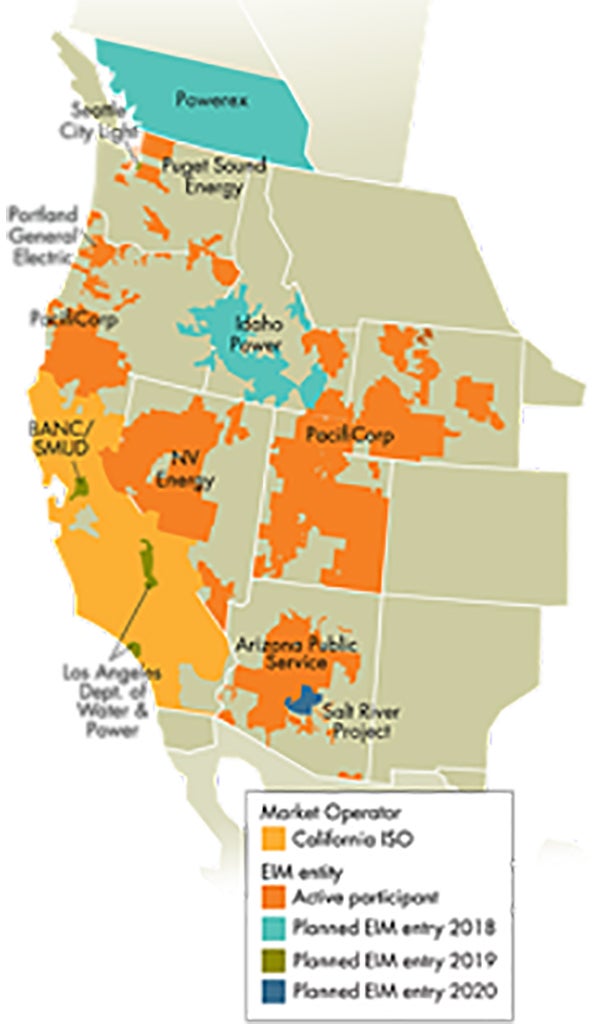

Stephanie Lenhart is a Visiting Assistant Professor in the School of Public Service at Boise State University specializing in energy and environmental policy. She earned her BA from Cornell University, her MPP from University of California at Berkeley and her PhD in Environmental, Natural Resources, and Energy Policy from Boise State University. Her work has appeared in Energy Research and Social Science and the Scholar Strategy Network.
Last September, as California lawmakers worked to wrap up their 2017 legislative session, the western electricity grid became a subject of controversy. Eleventh-hour legislation sponsored by State Assembly Member Chris Holden (D) would have opened the door for California to import more wind energy from Wyoming and to export more solar energy to other western states. The legislation would have done this by initiating a process to more fully integrate electricity markets and electricity governance in the West.
A fully organized multi-state electricity market facilitates competition among electricity generators by determining a cost-optimized mix of energy resources subject to the reliability constraints of the grid. This type of centralized and automated market is critical if California is to cost-effectively reach the goal of 100% clean energy. However, regionalization makes some labor unions, consumer groups, environmental groups, and politicians nervous. In challenging the bill, opponents warned it would reduce California’s control over energy policy decisions, with one consumer group asking, “Why would a California legislature resisting Trump’s evisceration of our environmental and consumer rights risk giving Trump appointees new power to invalidate California laws and agreements?” In the last week of the California session, the regionalization bill died, as did a separate intensely debated bill that would have set a target for the state to obtain 100% of its electricity from clean energy sources.
While the election of President Trump heightens concerns among Democrats and other stakeholders in California about sharing authority with the Federal Energy Regulatory Commission (FERC) and with other more conservative western states, the mistrust among electricity stakeholders in the American west is longstanding and more complex than a reaction to this particular president. Electricity systems around the world are becoming more integrated and interdependent. In most of North America, regional transmission organizations (RTOs) manage complex networks of infrastructure and markets to balance electricity supply and demand. Regional grid integration and organized markets improve reliability and economic efficiency and are critical for integrating high levels of wind and solar. However, the electricity system in the western United States has remained relatively fragmented. While most of California participates in a fully organized energy market operated by an RTO, in the remaining western states some thirty-three separate balancing authorities are responsible for matching supply and demand and coordinating with each other for infrastructure planning and reserves. Despite multiple attempts to extend or create new organized markets, the western region has, until recently, resisted these efforts and continued to operate with a decentralized and often fractious electricity decision-making structure.
A QUESTION OF GOVERNANCE
When regulators, utilities, and other stakeholders agreed to trade electricity among voluntary market participants through an energy imbalance market (EIM), it marked a significant, albeit limited, move toward western electricity grid integration. Because electricity cannot be efficiently stored, grid operators balance supply and demand of electricity in real-time. The EIM allows real-time trading to address unforeseen imbalances; whereas, a fully organized market includes electricity trading in a day-ahead market based on forecast demand. The seating of an EIM governing body in the summer of 2016 is the first successful extension of regional transmission system governance in the Western United States. It extends an RTO market platform operated by the California Independent System Operator (CAISO) and brings stakeholders from the “clean energy” states of California and Oregon together with stakeholders from the “coal” states of Utah and Wyoming. To date, eleven utilities have joined the EIM including PacifiCorp, the parent company for Rocky Mountain Power, and Idaho Power, which will begin active electricity trading in 2018 (see map). Since EIM trading began in 2014, more efficient dispatch of energy resources has resulted in $254.98 million in total benefits. In addition, the EIM is allowing more renewables to be exchanged in the market.

The highly controversial question of how to govern this newly forming market was critical to the success of the initiative and provides insights for the ongoing deliberations of western grid integration. To understand how this initiative unfolded and why this effort succeeded where others failed, my research explores policy implementation as the outcome of the social negotiation of authority. The EIM governance initiative has two important implications for stakeholders who are interested in facilitating grid integration: 1) flexible and evolving governance can facilitate collaboration by balancing the tensions in organized markets, and 2) the relationships that are emerging in EIM governance and the perceived legitimacy of this structure can serve as an important rationale for practices.
OVERCOMING A DYNAMIC OF MISTRUST
The longstanding resistance to organized markets in the western United States reflects not only a fundamental tension between energy system values, but also a shared resistance to ceding additional authority to federal regulators. Western states differ widely in clean energy policies, electricity affordability, energy resource mix, and regulatory relationships with investor-owned and community-owned utilities. Yet, many stakeholders across the west share a belief that their own political and market interests are served by retaining independence, rather than engaging in the collective activities of a multi-state RTO. My dissertation examines stakeholder perspectives through interviews, field observations, and document analysis and provides insights into this dynamic. As one stakeholder interviewed for that project explained, a multi-state RTO “…limits the flexibility of states to pursue their state energy policies because those markets tend to try to treat everything on exactly the same basis.”
As this response highlights, many stakeholders within California are skeptical of expanding to a multi-state RTO because market design and clean energy objectives would be more difficult to negotiate and would involve ceding additional authority to FERC proceedings and the courts to arbitrate conflicts. Similarly, stakeholders outside of California express concerns about the inherent risks of engaging in a more dynamic governance system and their ability to maintain affordability and reliability. Over the years, repeated interactions among stakeholders on this issue have reinforced a narrative I documented in my dissertation around a preference for “homegrown solutions” and “local control,” and the need to “protect state interests.”
However, this belief that independence protects a state’s ability to pursue its own energy policy goals is being challenged. In the two decades since the first organized electricity markets were formed, technological innovation and policies promoting clean, low-carbon energy have spurred advances in communication, information, and control systems as well as the rapid growth of renewable resources. Wind and solar have transformed the resource mix and now account for more than 12% of annual net generation in the western United States. These new technologies and resources are driving electricity systems to become even more integrated because they increase the economic and reliability benefits of regional governance.
This type of policy implementation involves ambiguous authority relationships and competing sources of authority that must be reconciled. Therefore, the significance of any particular authority depends on how it is interpreted. To access at least a portion of these benefits, stakeholders seeking to establish the EIM engaged in coordination and collaboration. Among the many coordination and collaboration strategies employed by these stakeholders, two are particularly relevant for thinking about how to facilitate the broader initiative to create a fully organized western electricity market.

FLEXIBLE AND EVOLVING STRUCTURES ENABLE COLLABORATION
First, all RTOs must balance inherent tensions between political autonomy and market efficiency and must balance state and local policy goals with the requirements of market independence. EIM stakeholders were able to balance these tensions by sustaining alternative interpretations of how the EIM served each of these goals, rather than reaching a consensus about the purpose and future of the EIM.
The EIM is a unique and complex set of material practices developed through diverse venues over the course of nearly a decade. Through this process, stakeholders have developed various taken-for-granted meanings of what the EIM is and what it is intended to achieve. Through deliberations of a stakeholder committee, a shared governance approach was eventually adopted. This approach avoids competing filings that would be arbitrated by FERC, but requires stakeholders to engage in the deeply technical work of market design, operations, and planning. Importantly, this approach legitimates engagement in the EIM as a pragmatic and potentially temporary structure. Thus, the flexible and evolving nature of EIM governance was critical for overcoming the longstanding resistance to collective action, balancing the inherent tensions of engaging in organized electricity markets and providing new rationale for coordination.
RELATIONAL AUTHORITY PROVIDES AN IMPORTANT RATIONALE FOR COORDINATED PRACTICES
Second, the stakeholder committee working on EIM governance recognized that CAISO, California’s manager of the market platform, needed to interact in new ways for EIM governance to be perceived as legitimate and to attract new market participants. Specifically, the committee created new governance structures for state regulators, public power, civil society organizations, adjacent balancing authorities, and other stakeholders to interact with each other, with the CAISO board, and with the EIM governing body. By creating space for interactions rather than hierarchical structures, the committee sought to provide tangible relational authority and acknowledged the importance of communication, relationships, and trust as emergent sources of authority. As EIM governance has been put into place, participants have noted the value of these structures. The relational authority that has developed through deliberation and enactment of EIM governance provides an important rationale for coordinated practices.

THE EIM IS FOUNDATIONAL FOR THE FUTURE OF THE WESTERN GRID
Although the initiative to create a multi-state RTO is currently stalled, the experience of forming the EIM provides practical insights for this effort. In complex systems like organized electricity markets, it is difficult to define hierarchies and rules to coordinate actions. In these systems, collaboration is facilitated by flexible and evolving relationships that allow temporary and pragmatic solutions and enable stakeholder interactions.
The American west has taken a unique approach to electricity system governance. For now, the EIM is an innovative alternative to a fully organized market. As such, the EIM is fundamentally reshaping interactions among CAISO, EIM participants, and neighboring balancing authorities. The EIM is also providing experience with innovative structures, new sources of authority, and building relationships that will shape the future grid. The success thus far of the EIM suggests there is much to be gained in supporting flexible governance structures and relational authority.
Our ability to eventually sell Wyoming wind to California and create a more efficient electricity system by optimizing the geographic and demand diversity across the western United States depends on overcoming a complex legacy of mistrust. The last-minute efforts to push through California legislation have only increased concerns about motivations and the balance of power among participants. In contrast, the trust that is developing among EIM participants is foundational for the future of the western grid.